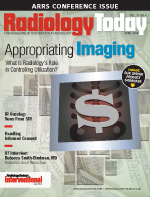April 2010

Tracking the Tip — Improving Accuracy
for Needle Biopsies
By Steven K. Wagner
Radiology Today
Vol. 11 No. 4 P. 30
Since ultrasound-guided needle biopsy first became widely used, one notable limitation has held it in check: surgeons’ inability to hit targets with pinpoint accuracy every time.
A group of medical imaging leaders is working to eliminate that shortcoming by joining forces on a cost-effective 3D freehand biopsy guidance system, one that enables real-time percutaneous lesion biopsy without requiring radiation or open surgery.
Ascension Technology Corp developed a 0.9-mm-diameter six-degrees-of-freedom sensor for the application along with a 1.8-mm sensor for scanhead localization. CIVCO Medical Solutions contributed a proprietary tracking needle with a protective reusable housing for the sensor. When combined with ultrasound—Ultrasonix Medical Corporation and GE Healthcare both are incorporating the sensors and needle system in high-end platforms—and sophisticated visualization software, the technology enables simultaneous tracking of the distal tip of a needle and the ultrasound scan planes. This allows clinicians to visualize in real time the patient anatomy and needle tip position with improved accuracy.
“With existing technology, blind spots such as bone or gas pockets can block the ultrasound signal,” says Willet F. Whitmore III, MD, chief medical officer for CIVCO. “This technology allows clinicians to continuously know exactly where the tip is in relation to whatever is seen on the ultrasound image.”
3D Tracking
Historically, ultrasound alone could not ensure that the tip of a biopsy needle or the electrodes on an ablation probe would strike the center of a lesion. This new approach attempts to eliminate the guesswork and needle placement inconsistency inherent in ultrasound-assisted biopsy and radio-frequency ablation by instantaneously tracking both the 3D location of the transducer and the needle tip. When preoperative imaging is required, the sensor aligns the real-time ultrasound image with the preoperative images via image fusion.
With fusion, the sensor’s real-time spatial data are graphically overlaid on video images of the scan plane. The clinician then monitors the needle trajectory in real time through delicate anatomy toward the center of a tissue target, such as a tumor. The process is designed to enable clear visualization of the needle location to ensure an accurate longitudinal or transverse approach.
Before the skin is penetrated, the guidance system registers the biopsy needle to the center of a target, enabling the user to select a path avoiding structures that may block it. As the needle pushes forward, fused images provide real-time information while guiding it along an ideal path. Once positioned, the needle can be rotated to a perpendicular plane to provide 3D verification that positioning is optimal.
“If you reinforce the ultrasound image with a fused CT or MR image, targeting becomes even better,” Whitmore says. “With optical tracking, you need line of sight. With electromagnetic tracking, you can track inside a body as long as the electromagnetic field can be transmitted into or through that body. It allows us to track something that can’t be visualized otherwise.”
To meet GE’s fusion requirements, Ascension developed 3D Guidance driveBAY, a magnetic motion tracker that allows users to select update rates of up to 420 times per second for multiple miniaturized sensors.
“We decided to partner with Ascension on our LOGIQ E9 ultrasound product based upon the company’s ability to work with us to define what we needed to achieve and based upon the positive experience we’d had in the past working with them on our LOGIQ 9,” says Mike Washburn, principal engineer for GE Healthcare. “We’ve been very happy with Ascension and its ability to develop cutting-edge sensors down to an optimal size.”
Designed for unobtrusiveness and ease of use, the sensors range in size from 0.9 mm down. Tracking is unaffected by close proximity to various traditional impediments such as stainless steel, aluminum, and titanium. When combined with Ascension’s flat magnetic field generator, the system can be used on gurneys, hospital beds, and procedural tables without measurement distortion.
Many Applications
Potential applications include neurosurgery, cardiology, and breast care. Specifically, the system enables the diagnostic biopsy of tumors, cysts, and other lesions; the ablation of various malignancies; nerve blocking; and access to blood vessels deep within the body. With robotics and creative minimally invasive procedures such as endoscopic fine-needle injection for gene therapy becoming more common, the potential uses are numerous. Potential advantages include increased physician confidence, fewer needle passes, reduced patient discomfort and anxiety, faster recovery, and reduced surgical time and expense. Experienced physicians now spend one to two hours positioning needles for traditional ablation procedures; Whitmore says the biopsy guidance system can reduce that to 10 minutes or less.
Improved visualization and needle placement should mean fewer costly incisional surgeries and fewer complications such as inadvertently striking pathway obstructions.
“The system allows users to see things that couldn’t be seen before,” says Tomas Bobovsky, a software engineer for Ultrasonix. “In the old days, you had your 2D ultrasound system and a needle. With this system, ultrasound isn’t even needed for guidance; ultrasound is used for diagnosis and the guidance system guides the needle.”
“Even experienced freehanders are made better almost immediately in most circumstances,” Whitmore says. “While the old process won’t completely disappear, for difficult cases, this is definitely the wave of the future for needle guidance.”
— Steven K. Wagner is a freelance writer based in southern California.

